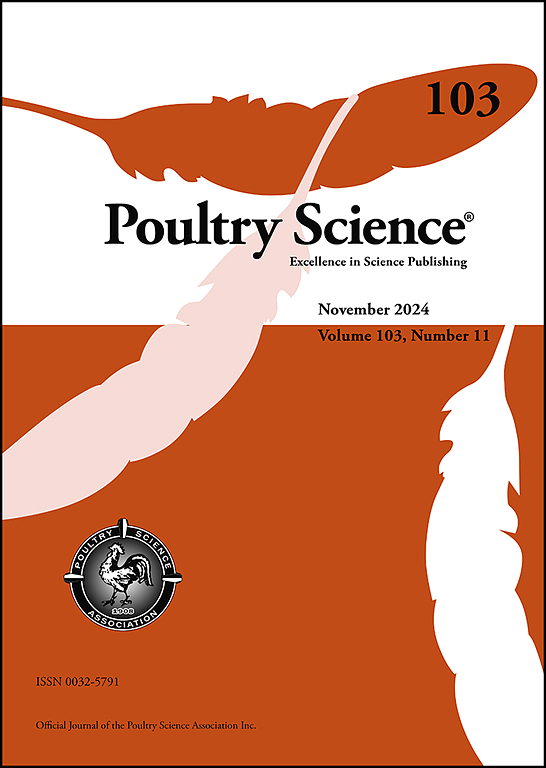意大利东北部家禽屠宰场过程卫生标准评价:2021-2023年自查与官方控制的比较分析
IF 4.2
1区 农林科学
Q1 AGRICULTURE, DAIRY & ANIMAL SCIENCE
引用次数: 0
摘要
弯曲杆菌和沙门氏菌的过程卫生标准(PHC)为屠宰场家禽加工的卫生标准提供了必要的指导。欧洲会员国收集的数据显示,官方核查结果与内部监测结果之间存在不一致之处,突出表明需要进行全面调查,以揭示这些差异背后的原因。本研究综合了来自供应农场代表性样本的生产特征和流行病学监测数据,调查了9个家禽屠宰场的PHC与经营因素的关系。该分析是基于2021年至2023年收集的微生物检测结果。定期对初级保健中心进行监测,创建一个“移动窗口”的数据,以评估一段时间内的卫生表现。调查结果显示,主管部门检测的样本中弯曲杆菌(27.6%)和沙门氏菌(30.7%)的患病率高于食品经营者检测的样本(分别为13.0%和8.7%)。然而,配对观察结果之间存在统计学显著差异(P <;0.05),仅在4个高通量屠宰场检测到。在9间屠房中,有6间在达到欧盟委员会规例2073/2005所订卫生标准方面面临挑战,在过去3年里,经常出现不符合规定的情况,占其总营运时间的17.0%至82.0%。分离沙门氏菌的血清分型发现,婴儿沙门氏菌的流行率很高(61.7%),在农场样本中也很普遍(72.0%),经常与该地区与禽肉有关的人类病例有关,强调了其公共卫生重要性。该研究强调了强有力的抽样方案对fbo和ca进行比较评估的重要性,以及持续改进卫生管理的必要性。欧洲食品安全局(EFSA)报告的FBO和CA采样结果之间的差异在本研究中主要归因于CA采用的较低采样频率,这可能只捕获了一小部分微生物变异性。PHC的反复破坏强调了目前在控制微生物负荷方面的干预措施的有效性。这些发现强调需要在整个生产链中采取综合控制措施,包括监测新出现的血清型和抗微生物药物耐药性监测。本文章由计算机程序翻译,如有差异,请以英文原文为准。
Assessment of process hygiene criteria in poultry slaughterhouses: A comparative analysis of own-checks and official controls in Northeast Italy (2021-2023)
Process hygiene criteria (PHC) for Campylobacter and Salmonella provide essential guidance on hygiene standards for poultry processing at slaughterhouses. Data collected by Member States (MSs) in Europe revealed inconsistencies between official verification and internal monitoring results, highlighting the need for a comprehensive investigation to uncover the reasons behind these discrepancies. This study investigated PHC in relation to operational factors at nine poultry slaughterhouses, integrating production characteristics and epidemiological surveillance data from a representative sample of supplying farms. The analysis is based on microbiological testing results collected between 2021 and 2023. PHC were monitored at regular intervals, creating a “moving window” of data to assess hygienic performance over time. The findings indicated that samples tested by competent authorities (CAs) showed higher prevalence rates of Campylobacter (27.6 %) and Salmonella (30.7 %) compared to those tested by food business operators (FBOs) (13.0 % and 8.7 %, respectively). However, statistically significant differences between paired observations (P < 0.05) were detected only in four high-throughput slaughterhouses. Six of the nine slaughterhouses face challenges in meeting the hygiene standards established by EC Regulation 2073/2005, with recurring non-compliance over three years, representing 17.0 % to 82.0 % of their total operational time. Serotyping of Salmonella isolates identified a high prevalence of S. Infantis (61.7 %), also prevalent in farm samples (72.0 %), frequently linked to human cases related to poultry meat in the region, underscoring its public health importance. The study highlights the importance of robust sampling protocols for comparative assessments by FBOs and CAs, alongside the need for continuous improvement in hygiene management. Discrepancies between FBO and CA sampling results, as reported by European Food Safety Authority (EFSA), in this study are largely attributed to the lower sampling frequency employed by CAs, which likely captures only a fraction of the microbial variability. Recurrent breaches of PHC underscore the ineffectiveness of current interventions in controlling microbial loads. These findings emphasize the need for comprehensive control measures throughout the production chain, including surveillance of emerging serovars and antimicrobial resistance monitoring.
求助全文
通过发布文献求助,成功后即可免费获取论文全文。
去求助
来源期刊

Poultry Science
农林科学-奶制品与动物科学
CiteScore
7.60
自引率
15.90%
发文量
0
审稿时长
94 days
期刊介绍:
First self-published in 1921, Poultry Science is an internationally renowned monthly journal, known as the authoritative source for a broad range of poultry information and high-caliber research. The journal plays a pivotal role in the dissemination of preeminent poultry-related knowledge across all disciplines. As of January 2020, Poultry Science will become an Open Access journal with no subscription charges, meaning authors who publish here can make their research immediately, permanently, and freely accessible worldwide while retaining copyright to their work. Papers submitted for publication after October 1, 2019 will be published as Open Access papers.
An international journal, Poultry Science publishes original papers, research notes, symposium papers, and reviews of basic science as applied to poultry. This authoritative source of poultry information is consistently ranked by ISI Impact Factor as one of the top 10 agriculture, dairy and animal science journals to deliver high-caliber research. Currently it is the highest-ranked (by Impact Factor and Eigenfactor) journal dedicated to publishing poultry research. Subject areas include breeding, genetics, education, production, management, environment, health, behavior, welfare, immunology, molecular biology, metabolism, nutrition, physiology, reproduction, processing, and products.
 求助内容:
求助内容: 应助结果提醒方式:
应助结果提醒方式:


